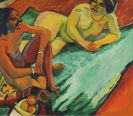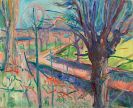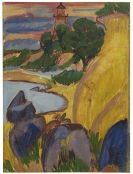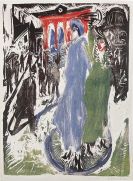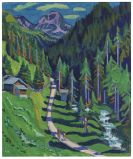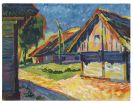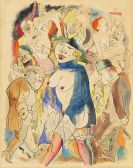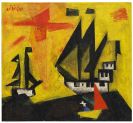
Elfriede Lohse-Wächtler
Dresden
1899 -
Pirna
1940
Elfriede Lohse-Wächtler was born in Dresden on 4 December 1899 and began training as an artist in 1915 in the specialist class for fashion and commercial graphics at the Dresden School for the Decorative and Applied Arts. She also took extracurricular courses in drawing and painting with O. Gussmann at the Dresden Fine Art Academy. Elfriede Wächtler came into contact with Pfemfert's circle, the Berlin Dadaists and, most importantly, the Dresden "1919 Secession Group".
Otto Dix and Conrad Felixmüller introduced Elfriede Wächtler to the artist and singer Kurt Lohse and they married in 1921. They had a house together in Wehlen, where Elfriede Wächtler-Lohse also sculpted. In 1925 the couple moved to Hamburg, where Kurt Lohse found employment as a singer in a chorus. The couple separated in 1926 after harrowin marital crises.
Elfriede Lohse-Wächtler's most creative phase coincided with the Hamburg period. Her main works in oils, pastels and watercolour - portraits of familiar and anonymous subjects, couples, prostitutes and subject matter drawn from the working-class environment - were done between 1927 and 1931. After suffering a nervous breakdown, Elfriede Lohse-Wächtler was committed to the Hamburg-Friedrichsberg psychiatric clinic in 1929. There she did the "Friedrichsberger Köpfe", roughly sixty drawings and head and body studies in pastels of psychiatric patients.
In 1930-31 Lohse-Wächtler showed work at various exhibitions at venues that included the Hamburg Kunsthalle. Elfriede Lohse-Wächtler returned to her parents' home in Dresden in 1931; her mental state deteriorated and at her father's instigation she was committed to the Arnsdorf psychiatric institution, where she was diagnosed as schizophrenic. Although she initially had the opportunity of working as an artist, she was subsequently declared mentally incompetent, divorced and sterilised so that by 1935 her creativity was exhausted.
Defamed as "degenerate art" in 1937, Lohse-Wächtler's work was in part destroyed. She herself was a victim of the National Socialist regime and died in the gas chamber at Pirna-Sonnenschein under the auspices of the "T4" euthanasia programme on 31 July or 1 August 1940.
Although Elfriede Lohse-Wächtler's work was esteemed and acclaimed until the 1930s, it was afterwards consigned to oblivion, not least due to her tragic fate. From 1959, however, the remarkable work of this woman painter of the "lost generation", who was close to Expressive realism, was rediscovered and given the recognition that had so long been undeservedly withheld.
Would you like to sell a work by Elfriede Lohse-Wächtler?
Infos for seller
